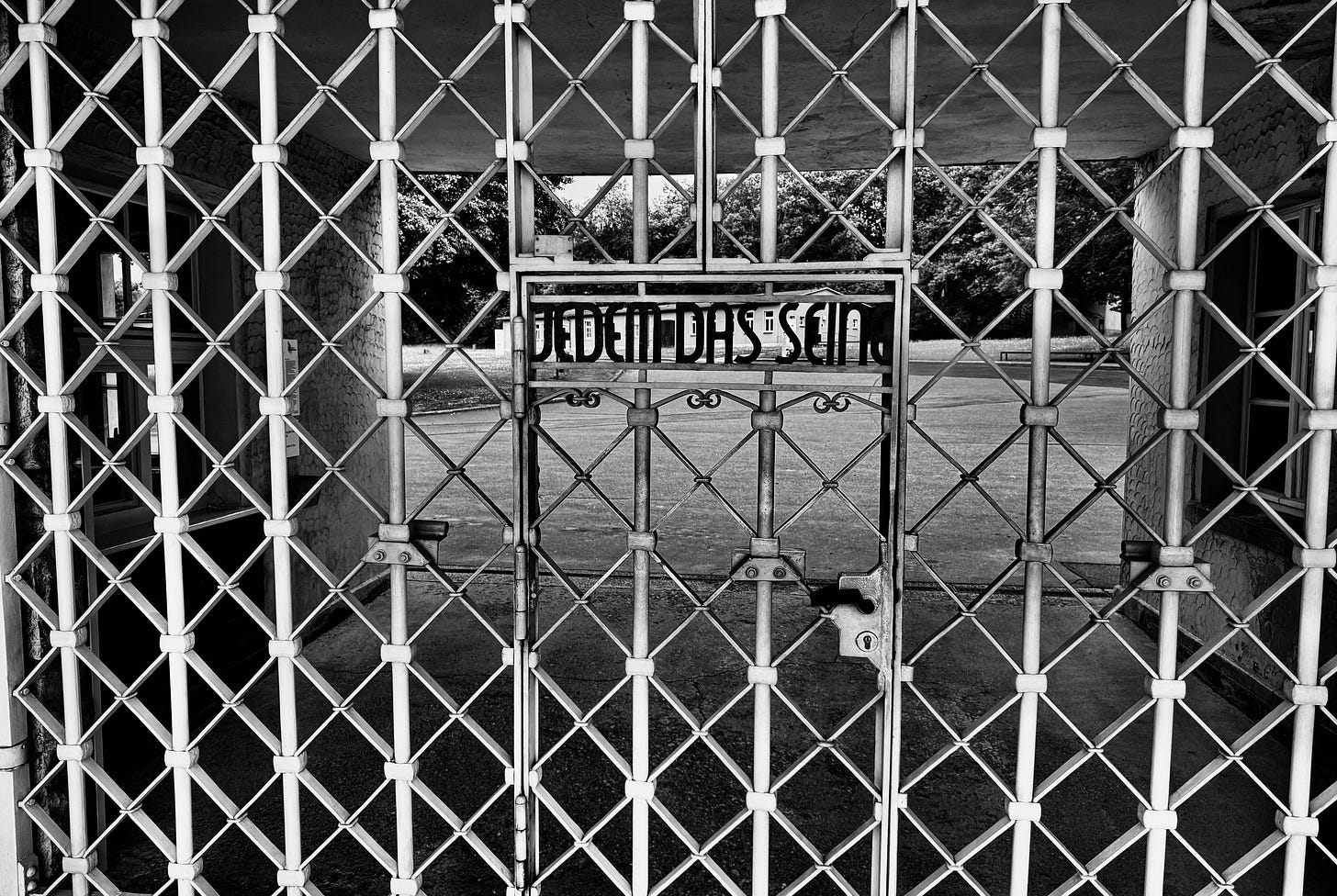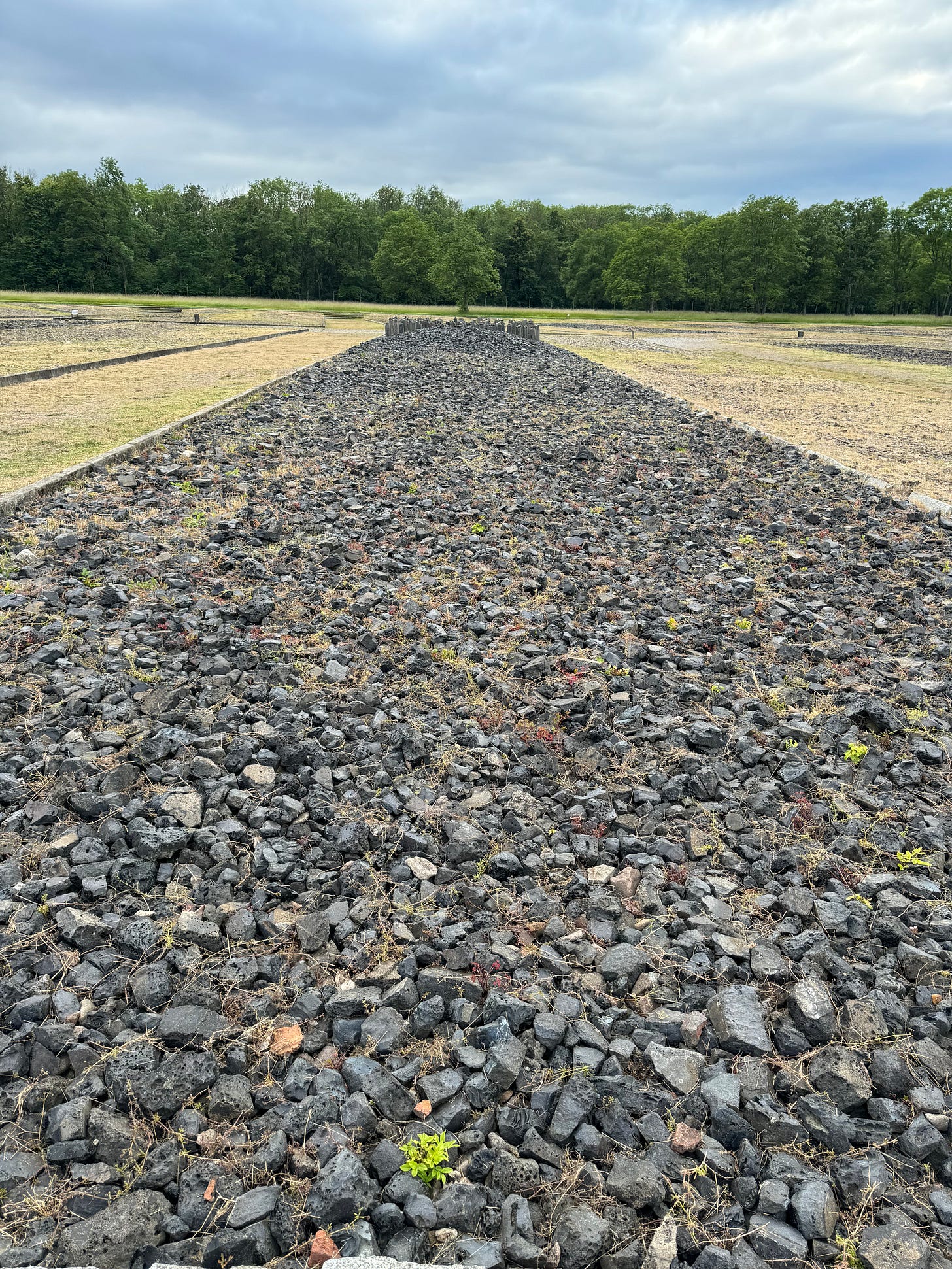Buchenwald, football and a journey into the heart of darkness.
Drive north from the tranquil fields around England’s Euro 2024 training base and you reach the elegant town of Weimar, home of Goethe and Schiller, pillars of German culture. Drive west through more serene countryside and the route begins to rise. I catch its name, “Blood Road”, and the mood and narrative change. Gone is the beauty. The road continues upward but really it’s a descent into the heart of darkness.
For up ahead, the car parked up, lies the hell that is Buchenwald concentration camp. It’s early evening and museum staff have left for the day, the place is deserted, but the ghosts remain. Shadows fall across the barbed-wire fences and stretch across this killing field carved out of a hillside forest. It’s getting on for 7pm but the clock above the entrance gate at the main SS command building shows 3.15, the moment the camp was liberated by American soldiers on April 11, 1945; 21,000 inmates were freed, including 900 children.
My eyes turn from the clock to the sign above the metal gate that reads “JEDEM DAS SEINE”, “TO EACH HIS OWN”. As the detailed Buchenwald Memorial online guide explains, “the motto is intended to justify the isolation and murder of the inmates by the SS”. The colour has faded but was painted red on the camp-side.
The gate is closed but opens with a smooth, efficient click, and I step on to a vast, 100-acre expanse of gravel and outlines of the 60 old camp barracks which housed the inmates. 56,545 perished at Buchenwald: Jews, Poles, Sinti, Romani, political prisoners, Russians, so many more, so many differing nationalities and communities. Memorials and wreaths dotted around remember them.
Death arrived in many forms, a bullet to the back of the head, overwork, under-nourishment, torture and medical experiments in one of the nondescript-looking buildings or being hanged by their wrists from trees in the “Singing Forest” so-called because of the screams. Other inmates were dragged away and gassed.
And when the SS finished their murderous work for the day, not that it ever stopped just another shift clocked on, some of the officers casually went off and played football. The contrast between the SS’s joy in sport and the malevolence of their main activity of slaughter is well-captured in the current exhibition alongside the huts. With the European Championship on German soil, Buchenwald Memorial staff have taken the opportunity “to highlight the links between football and the history of Buchenwald concentration camp for the first time”. It leads into a debate about the banality of normal life that can accompany evil, the officers going about their every-day family existence and then marching through the gates and destroying families.
The SS formed a team and scoured Weimar for a coach. It was into this macabre world that Fritz Forderer stepped. He’d played 11 times for Germany and also won the league with Karlsruhe, become a trainer after World War I and found work as a groundsman and sports teacher in Weimar in April 1939.
A report from Kicker magazine in the 1930s, contained in the City of Leipzig Historical Museum archives and exhibited at Buchenwald, hailed Forderer’s qualities for an accomplished Karlsruhe side that “one player stood out in particular with his shooting power, his explosive style of play and his temperament. That was the right-winger Fritz Forderer, “Frieder”, as even the youngest players affectionately and respectfully called him.”
Kicker added of Forderer that, “He also learned a lot from the English champion trainer William Townley”, a remarkable character who played on the left wing for Blackburn Rovers, Manchester City and twice for England in 1889-90, went into coaching on the Continent, and oversaw Karlsruhe’s only ever title triumph in 1910 with Foderer.
Accompanying the Buchenwald exhibition is a 1930s’ album of pen-pics of Karlsruhe players with Forderer prominent. “His national team colleagues Julius Hirsch and Gottfried Fuchs were missing from the album, which featured all national team players, for racist reasons.” Hirsch and Fuchs were Jewish.
Hirsch won the Iron Cross in World War I and represented Germany seven times but with the rise of the Nazis he was ostracised by Karlsruhe, divorced his Protestant wife to save her, and he was ordered to report to Essen station. His daughter went with Hirsch to station, and later wrote, “to this day I don’t understand how the sun could have been shining. We didn’t believe that we would never see him again”. They never did. He was being taken to Auschwitz-Birkenau.
Fuchs played six times as a forward for Germany, and scored a then world-record 10 goals in one game against Russia. He also won an Iron Cross in World War I. He escaped the Holocaust by fleeing to England before settling in Canada.
Their former team-mate with club and country, Forderer, was living in Weimar before World War II. On hearing that such a famous former player was in the vicinity, the SS requested the Mayor of Weimar that Forderer be seconded to them as a coach. So he did, coaching them.
Within the fences were some famous footballing names. Julian Lehmann, a former player with Eintracht Frankfurt, was held in Buchenwald for three months. Eugene Maes, the prolific France forward (15 goals in 11 internationals), was also held here. Neither survived the war.
Dr Josef Garo, briefly a player who became president of the Austrian FA and vice-president of Uefa, was an enthusiastic supporter of the European Championship. He spent almost 18 months in Buchenwald. Henrik Nadler played for the Budapest side MTK and Hungary, and celebrated in one report as “a ball acrobat of the highest order” was incarcerated in Buchenwald before being placed on the list of those taken to Bergen-Belsen. Nadler was never heard from again.
The SS permitted the inmates, some of them talented footballers, to play games on Sunday afternoon. The first game in 1939, on Easter Sunday, was a fixture described in a report as between “Jews” and “Aryans”. 2,000 spectators massed around the pitch. SS soldiers, leaning out of the windows of the command building, chanted “The Jews are our misfortune”.
Eventually, there were as many as 12 teams at Buchenwald, but most inmates were obviously too exhausted to commit to any additional physical exertion. When one political prisoner, Alfred Bunzol, sustained a leg injury in a game on June 4, 1939, he was taken away to the infirmary and then interrogated.
Visitors were taken to see any games going on. “For the SS, the games served to maintain the appearance of normality and conceal the criminal nature of the camp,” as the exhibition notes.
I close the gate, hear that click again, and head back to my car, and back to covering England. At Euro 2012, seven England players visited Auschwitz-Birkenau, which was near their base in Krakow. Wayne Rooney spoke powerfully about the impact it had on him.
England have to focus fully on these Euros, and rightly so, but it is good to hear that some Football Association staff have spoken of their desire to visit Buchenwald and pay their respects, not least because shot-down RAF pilots and crew were incarcerated here for two months before being moved into a POW camp.
Members of the England Supporters Travel Club went to Bergen-Belsen and laid a wreath “from all representatives of English football” with the tribute” “We remember. We stand with you in solidarity.” Lest we forget.





Thank you Henry. Very moving. Thank you for your generosity of spirit in taking the time to write this piece. Yet another element of the football story and how it fits into our lives. A ‘throwaway’ line, I know, but it is, indeed, more than just 22 blokes kicking a ball about.
I can only echo what you and others have said here. That you write on topics where football is not always the predominant subject is why I elected to subscribe to Goal Posts. What I find surprising about Buchenwald is that given its horrific history the Soviets used it as a prison during the post war years until 1950.